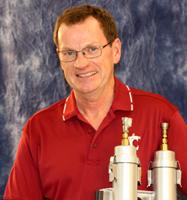
REACCH Connection:
Dr. Lamb is the leader of monitoring greenhouse gas emissions from cropping systems. This novel research informs climate change mitigation models and future policy.
Biography:
Brian Lamb and his colleagues measure the uptake of carbon dioxide and the release of nitrous oxide from farm fields for the project. The researchers installed instrumentation at several sites in a variety of Northwest climate zones over the next five years. In particular, the sites in Othello, Lind, Pullman, Genesee and Pendleton each have unique temperature and precipitation conditions. The researchers will be studying changes in carbon storage and greenhouse gas emissions as a variety of cropping techniques and growing practices are tested at these sites.
Lamb is a national leader in atmospheric monitoring. As part of this project, they are measuring greenhouse gases, including nitrous oxide, carbon dioxide, and methane over different cropping systems. The researchers couple measurements of wind velocity with chemical sensors to understand the chemicals’ movement through the environment and to understand how much they are being emitted or absorbed by the biosphere, which includes the crops and soils. Nitrous oxide is a particularly potent greenhouse gas and is emitted during agricultural activities, although it is in very small concentrations in the atmosphere. The measurements allow the researchers to understand how a change in farming techniques might change greenhouse gas emissions and help to mitigate climate change.
A WSU faculty member for almost 30 years, Lamb is an international leader in the area of regional air quality research.
He and his collaborators led the development of the Biogenic Emission Inventory System, which the Environmental Protection Agency adopted as a tool to address ozone problems. The system allows regulators to take into account how trees and natural organics impact pollution problems.
Lamb's research group also developed one of the first numerical air quality forecast systems in the nation. The system was developed and used originally in metropolitan cities in the Northwest to measure and predict the levels and movement of ozone, carbon monoxide and fine particulate matter that affect human health. It was later enhanced to include wildfire pollutant emissions and to predict the transport and dispersion of smoke and other pollutants from fires.

